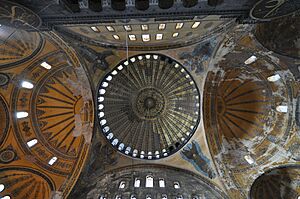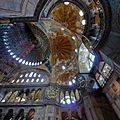Semi-dome facts for kids

A semi-dome is like half of a regular dome. It is also sometimes called a "half-dome."
Architects use semi-domes to cover a half-circle area. You often see them over an apse, which is a rounded part of a building. They can also be at the end of a long, curved ceiling called a barrel vault.
Contents
History of Semi-Domes
Semi-domes have been used in buildings for a very long time. They are a cool feature in many famous structures.
Ancient Uses
The Romans were among the first to use semi-domes. They used them to cover special statues in their temples. You could also find semi-domes in Roman baths and large palaces.
Churches and Mosques
Semi-domes are very common in old churches. They were an important part of Byzantine architecture and early Christian buildings. Many mosques and other Islamic buildings also feature them. Sometimes, these semi-domes were decorated with beautiful glass mosaics.
Later Developments
In the 500s, Ottoman builders started combining semi-domes with full domes. This made their buildings look even grander.
During the Early Middle Ages, semi-domes covered the rounded ends of churches in Britain. By the 11th century, almost every church in Normandy, France, had a semi-dome over its apse. Semi-domes became less common when churches started having square ends instead of rounded ones.
Images for kids
-
Typical Early Christian/Byzantine apse with a semi-dome decorated in mosaic (Basilica di Sant'Apollinare in Classe in Ravenna)
-
Looking up at the radiating semi-domes of Hagia Sophia
-
Exterior of the Sultan Ahmed Mosque
-
Interior of Sultan Ahmed Mosque ("Blue Mosque"), Istanbul. The main dome is surrounded by four semi-domes. They in turn have smaller semi-domes hanging off them.
-
Painted semi-dome; Parma Cathedral
-
Tribune with semi-dome, Winter Palace
See also
 In Spanish: Bóveda de horno para niños
In Spanish: Bóveda de horno para niños











